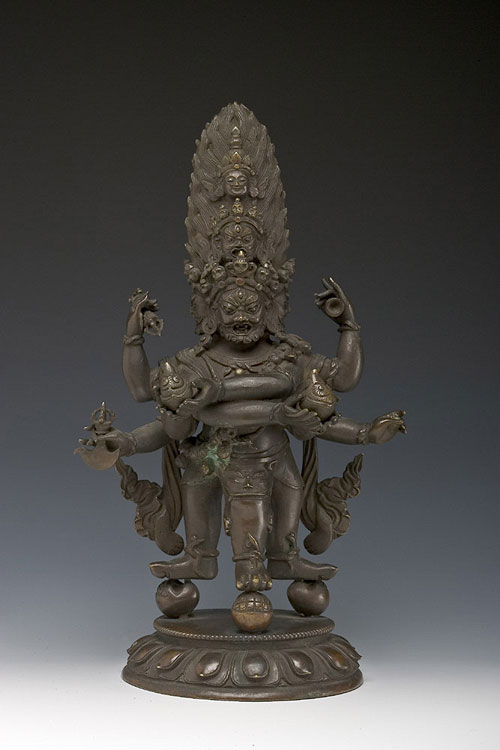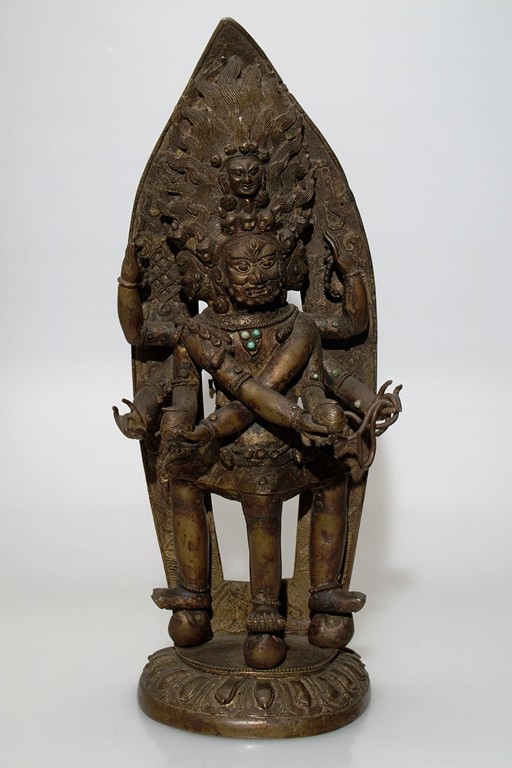Generally speaking, Himalayan Buddhist sculptures display 1 to 11 heads and 2 to 34 arms On paintings some deities may have 1000 faces, 1,000 arms, 1000 legs, Vajrabhairava may even have 900,000 faces, 1800,000 arms (see the Himalayan Art Resources website). On the other hand, Ekajati may have only one head, one arm, one leg. There are local variants, rare tantric forms and forms that do not match the description given in the texts.
The following list is not exhaustive and it is subject to constant updating, like the rest of this blog. The pictures have been published in various posts with photo credits and other details which are not repeated here.
1) ONE HEAD
One head+two arms

Undated, Tibet, Shakyamuni, bronze, at the Tibet House Museum in New Delhi, item 71791 on Himalayan Art Resources.
Apart from historical figures (in their normal form), many deities from the Himalayan pantheon always have one head and two arms but others may have one or more heads, two or more arms (and Ekajati may have only one arm, one leg, one eye etc.).
One head+four arms (chaturbhuja)
18th century, Tibet or Mongolia, Vajrapani, private collection.
Buddhakapala, Cunda, and two of the Pancha Raksha deities have one head and four arms. Vajrapani, Manjushri, Avalokiteshvara, Amoghapasha, Hevajra, Vajrasattva, Chakrasamvara, Humkara, Achala, Mahakala, Ganapati, Vajrapani, Janguli, Sarasvati, Prajnaparamita, Ekajati, Kurukulla, Shri Devi, Tara, may have one head and four arms.
One head+six arms (Shadbhuja)
Mahakala, wrathful Vajrapani, Chakrasamvara, Humkara, Guhyasamaja, Amoghapasha, Manjushri, Avalokiteshvara, Samantabhadra (bodhisattva), and possibly Hayagriva and Yama, have a one-head and six-arm form.
One head+eight arms
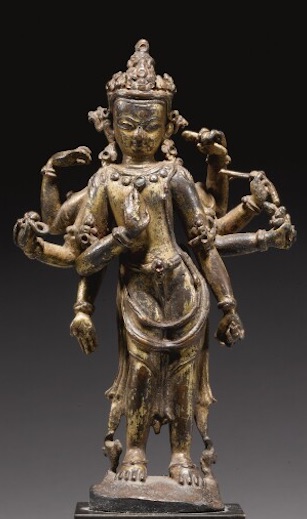
Undated (Malla period), Nepal, Amoghapasha Lokeshvara, gilt copper, private collection.
Amoghapasha, Ushnishavijaya, Tara have a one-head and eight-arm form.
One head+ten arms
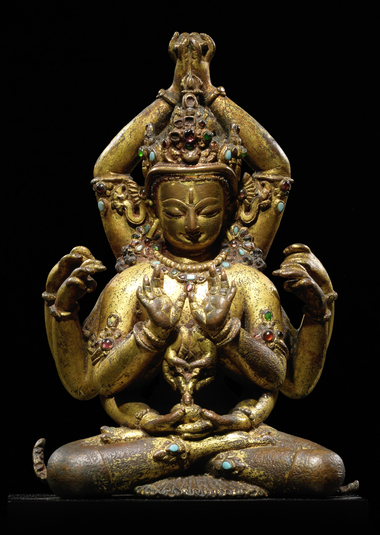
Undated (Malla period), Himalayan Region, Manjushri, private collection.
The intriguing Mayajala form of Manjushri has one head and ten arms, two of them held above his head.
One head+twelve arms
Amoghapasha, Manjushri, Avalokiteshvara, Chakrasamvara, may have one head and twelve arms.
2) TWO HEADS
Vajravarahi always has the head of a sow coming out of her temple (usually to her right) or on top of her main head. Marici may also have the head of a sow added to hers.
3) THREE HEADS
Three heads+two arms

10th-12th century, Tibet or Western Himalayas, Avalokiteshvara, at the Cleveland Museum of Art (USA).
Avalokiteshvara, Amoghapasha, Hevajra, Yamari, may have three heads, two arms, two legs. The heads are usually aligned in a semi-circular way. (The above is damaged and may have had eleven heads and eight hands).
Three heads+four arms

17th century Nepal, Ganapati, bronze with cold gold and pigments, Rubin Museum of Art collection, New York (USA).
Avalokiteshvara, Amoghapasha, Hayagriva, Vajrapani (wratfhul), may have three heads and four arms. This is a very rare example of Ganapati with two human heads one on top of the other plus an elephant head attached to one side.
Three heads + six arms
Most three-headed deities have six arms and two or four legs.
Three heads + eight arms

Undated (late Pala revival), Tibet, Ushnishavijaya, metal, private collection.
The female deities Ushnishavijaya, Marici, Mahamayuri, Sitatapatra may have three heads and eight arms.
On paintings, Sitatapatra and Pratisara sometimes have three heads and ten arms, and there is or was a rare Kashmiri sculpture of Humkara at the gTsug Lakhang temple in Lhasa (published by Ulrich von Schroeder and seen in a previous post) with three heads and possibly 18 hands.
4) FOUR HEADS
Four heads + two arms
Buddha Vairochana has a four-head and two-arm form and so does Chakrasamvara when depicted alone (mainly on paintings).
Four heads + four arms
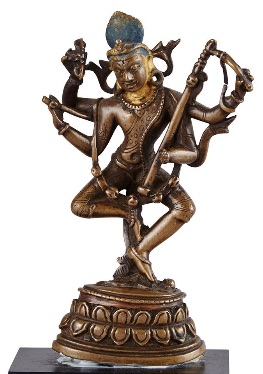
14th-16th century, Tibet, Mahamaya, bronze, private collection.
Mahamaya has one head with two arms or four heads with four arms, and two legs. Yamari, Trailokyavijaya, Mahakala, Achala, Vajrapani (wrathful), may have four heads with four arms and two or four legs.
On paintings, Vajrapani, Manjushri, Trailokyavijaya, may have four heads and six arms.
Four heads + eight arms
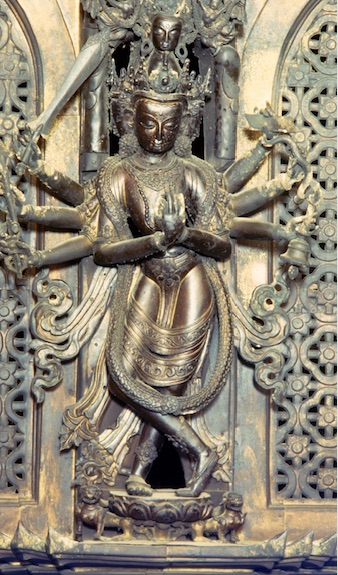
1409 CE, Nepal, Vajradhatuvagisvara Manjughosa, gilt copper alloy, photo nº 50362 on Huntington Archive
Manjushri, Vairochana, Pratisara, Tara, Trailokyavijaya, Vajrabhairava may have four heads and eight arms. When the back of the image cannot be seen (because of the backplate) the fourth head is placed on top of the others.
Four heads + twelve arms

16th-17th century, Nepal, Chakrasamvara and Vajravarahi, gilt copper inlaid with gems, at the Freer Sackler Gallery of the Smithsonian Institute in Washington DC (USA).
The most common form of Chakrasamvara (Samvara with consort) has four heads, twelve arms and two legs.
Four heads + twenty-four arms
Kalachakra normally has four heads and twenty-four arms.
5) FIVE HEADS
Five heads + six or eight arms
Apart from the three-legged deity featured further down, an archaic form of Manjushri (dharmadatu vagisvara) may have five heads and six or eight arms.
Five heads + ten arms
On paintings, Black Lokanata has five heads and ten arms, and Yamari, Marici, Sitatapatra may have five heads and ten arms.
6) SIX HEADS
Even fewer deities may have six heads, and they are normally seen on paintings: Yamari (six arms+six legs), Vajrabhairava, Marici (twelve arms), namasangiti Manjushri ( two or four arms).
7) SEVEN HEADS

Buddha Nageshvara Raja (Nagaraja), Tibet, undated, private collection.
One rare form of Hevajra may have seven heads as such. Buddha Nagaraja and Indian scholar Nagarjuna traditionally have a hood made of seven snakes (sometimes more). The former does a gestures specific to him that distinguishes him from Nagarjuna. In India, one form of Hayagriva may have four heads including Brahma’s head, which has four faces, thus totalling seven faces.
8) EIGHT HEADS
13th or 14th century, Nepal, Hevajra, gilt copper alloy, 8 heads + 16 arms, private collection.
Apart from an eight-head + eight-arm form of Vajrabhairava seen on paintings, Hevajra (guhyasamaja and Hradya forms) and Yellow Tara may have eight heads (and sixteen arms).
9) NINE HEADS
Nine heads + four arms
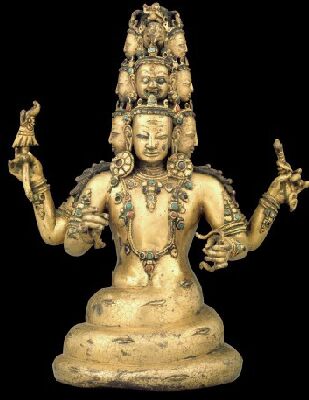
15th century, Tibet, gilt copper alloy inlaid with stones, at the Rubin Museum of Art in New York.
Worldly protector Rahula has nine heads (eight humans+a crow’s head in this case) and four arms.
Nine heads + eighteen arms
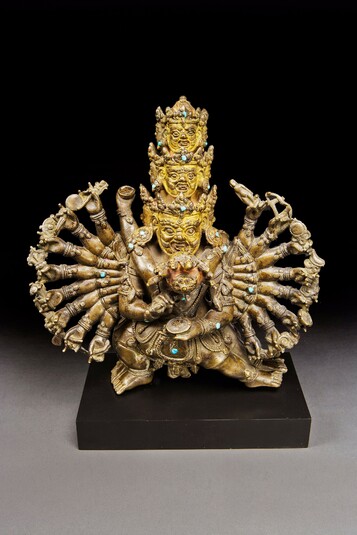
Shri Heruka, Tibet, undated, copper alloy with cold gold and pigments, private collection.
Shri Heruka may have nine heads and eighteen arms (mahottara form).
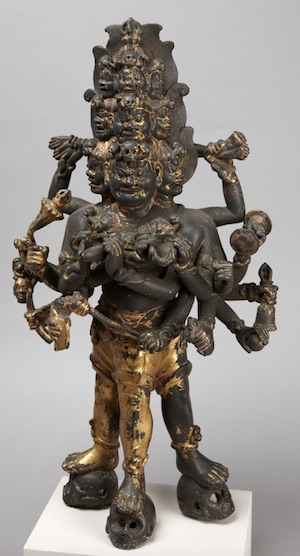
12th-13th century, Dali Kingdom, Mahakala, gilt bronze, 43,5 cm, inventory nº y1969-109 at the Princetown University Art Museum (USA).
A rare three-legged form of Mahakala has nine heads, eighteen arms, three legs.
Nine heads + thirty-four arms
The most common form of Vajrabhairava has nine heads and 34 arms. The heads may be stacked in three rows of three or arranged in a circular row of seven topped with one head plus Manjushri’s head at the top. To prevent breakage, the secondary arms are made from a single piece that looks like a wing on each side of the figure.
10) TEN HEADS
See next item.
11) ELEVEN HEADS

Undated (circa 11th century), Ladakh or Western Tibet?, brass with silver inlay, private collection.
This rare sculpture depicts the eleven-headed form of Avalokiteshvara seated, with six hands. The deity’s ten heads are arranged in three rows of three plus one, topped with Amitabha’s head at the top, making it eleven heads altogether.
Eleven heads + eight hands or more
Usually standing, this form of Avalokiteshvara commonly has eight arms. He may also have 42, or a 1000 on paintings (represented by concentric circles of hands on sculptures).
12) TWENTY-ONE HEADS
This form of Shri Heruka is usually seen on paintings. He may have three stacks of seven heads and 42 arms.
13) A THOUSAND FACES
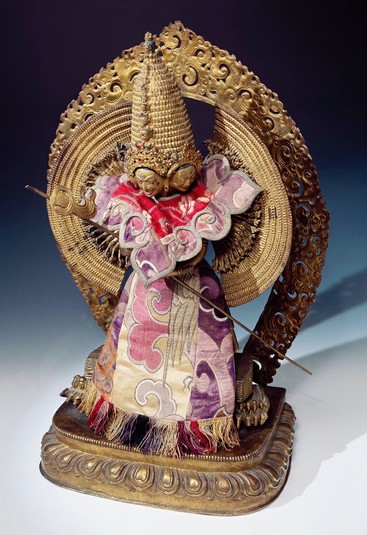
Undated (circa 18th century?), Tibet, Sitatapatra, metal, at the Pitt Rivers Museum in Oxford (UK).
Sitatapatra, Avalokiteshvara, Vajrabhairava may have a thousand faces and a thousand arms.
THREE-LEGGED DEITIES
This deity has five heads (four wrathful with three eyes plus Manjushri’s?), flaming hair, eight arms and three legs resting on two skulls and a skull cup filled with flesh. He is adorned with wrathful ornaments (skull crown, garland of freshly severed heads, tiger skin, snakes) and carries ritual implements such as a vajra sceptre and bell, a flaying knife, two skull cups filled with blood, and a missing attribute (possibly a lasso as below?).
This one has four heads with three eyes (a fifth head missing?), flaming hair, 8 arms, three legs standing on three skulls. He is adorned with snakes, skull crowns and a garland of freshly severed heads, and carries various ritual objects such as a lasso, two rosaries, and two skull cups. There is a knot of eternity on the arch behind him above his right shoulder. The single-lotus base design corresponds to 18th century works.
On Himalayan Art Resources they were originally labelled ‘Tangut protectors’. The Tangut or Tanghut were people of mixed ethnical origins, including Tibetans, with a common language and culture. They have been relabelled ‘Trailokyavijaya’ but may be derived from an esoteric from of Mahakala worshipped in the Dali Kingdom.













